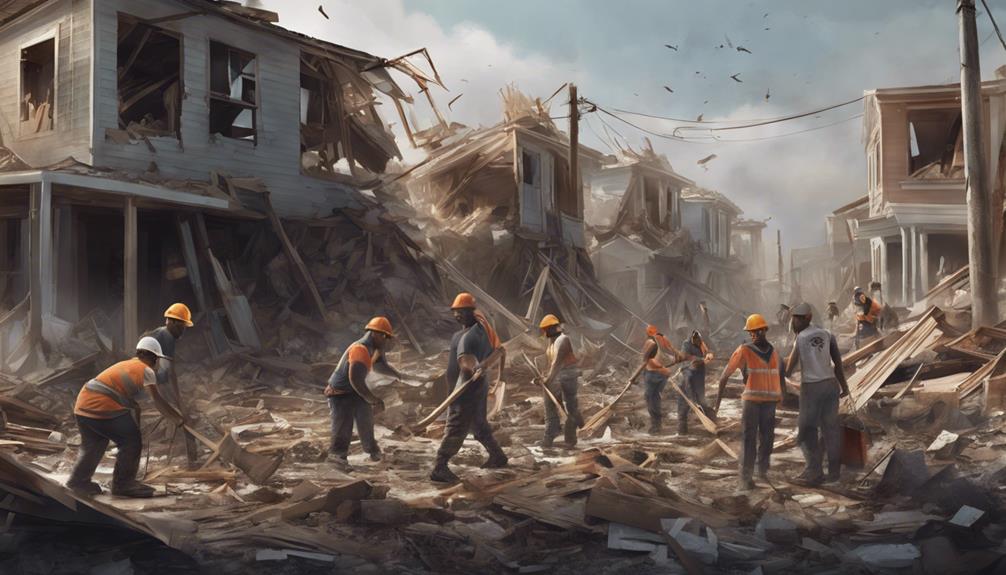In the aftermath of disasters, the plight of those affected requires a systematic and well-thought-out approach to provide effective assistance. Understanding the best ways to support these individuals and communities is crucial in ensuring their recovery and resilience. By exploring various avenues of aid, from financial contributions to hands-on volunteering, we can collectively make a profound difference in the lives of those grappling with the aftermath of calamities. The question remains, how can our efforts be maximized to offer the most substantial impact on disaster-affected populations?
Key Takeaways
- Donating money, essential items, and blood aids immediate relief efforts.
- Volunteer engagement provides direct impact, crucial aid, and trained response teams.
- Relief efforts like Red Cross support with shelters, meals, and supplies.
- Recovery support offers cleanup, financial aid, and coordinated donation efforts.
Donate Money to Relief Organizations

Donating funds to established relief organizations stands as a pivotal strategy in effectively aiding individuals impacted by disasters. Organizations like the Red Cross, a renowned disaster relief organization, play a crucial role in providing immediate assistance to those in need. When individuals raise money for disaster relief, it enables these organizations to swiftly respond to emergencies, offering essential supplies, medical care, and shelter to survivors.
Financial contributions ensure that resources are allocated efficiently based on the evolving needs of the disaster-affected areas. By supporting recognized disaster relief organizations, donors can have confidence that their donations are reaching the intended recipients and making a tangible difference in the lives of those facing adversity. Such donations are vital not only for addressing urgent requirements in the aftermath of a disaster but also for sustaining long-term recovery efforts and rebuilding communities. Therefore, contributing monetary aid to reputable relief organizations remains a critical aspect of providing comprehensive assistance to disaster victims.
Provide Essential Items for Survivors
How can essential items play a critical role in supporting disaster survivors' immediate needs and well-being? Providing essential items is crucial to help people affected by disasters and to support relief workers in their efforts. These items range from clothing, toiletries, bedding, and non-perishable food to supplies like flashlights, batteries, first aid kits, and hygiene products. Donating clean water is essential for hydration and sanitation, while blankets, towels, and personal hygiene items offer comfort. For families with infants, baby supplies such as diapers, formula, and baby food are indispensable.
To illustrate the importance of providing essential items, consider the following table:
| Essential Items | Purpose | Importance |
|---|---|---|
| Clothing | Shelter and protection | Provides warmth and comfort |
| Non-perishable food | Sustenance and nutrition | Meets basic dietary needs |
| Hygiene products | Sanitation and health | Prevents illnesses and infections |
Donate Blood for Medical Needs
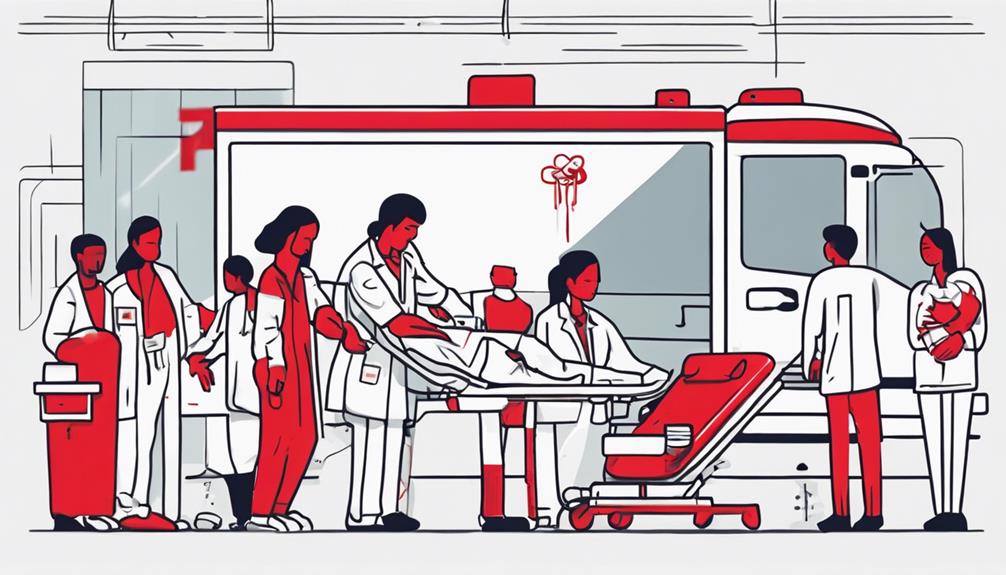
Blood donations play a critical role in meeting medical needs in disaster-affected areas, providing essential supplies for emergency treatment. While governments and businesses often send medical supplies during disasters, blood donations remain a vital and sometimes overlooked resource in disaster relief efforts. Donating blood can directly save lives and support the recovery of individuals impacted by disasters. In particular, O negative blood and platelets are highly valuable donations for medical treatment in disaster zones due to their universal compatibility. Online resources such as MSW@USC offer valuable information on the significant role of blood donations in natural disaster response efforts. Therefore, individuals looking to contribute to disaster relief can make a tangible impact by donating blood, which serves as a crucial component in providing medical care to those affected by disasters. By recognizing the importance of blood donations in disaster situations, we can better support the healthcare systems in these critical times.
Volunteer With Disaster Relief Agencies
Volunteering with disaster relief agencies offers individuals a direct opportunity to make a significant impact on those affected by disasters. Through specialized training and readiness programs, volunteers can enhance their skills and knowledge to effectively support relief efforts. By volunteering with these agencies, individuals provide crucial support to communities in need, fostering resilience and recovery after catastrophic events.
Direct Impact on Volunteers
In examining the direct impact on volunteers within disaster relief agencies, it becomes evident that their critical role is underscored by the fact that 95% of disaster relief workers are volunteers. These dedicated individuals play a crucial role in responding to natural disasters, offering essential help to people in need. Responding to emergencies every 8 minutes, they tackle an average of about 65,000 disasters yearly, with a focus on addressing immediate needs like those arising from home fires. Volunteers provide a range of vital services including overnight shelter stays, meals, emergency supplies, health services, and mental health support. By volunteering with disaster relief agencies, individuals directly contribute to providing hot meals, snacks, water, and essential services to those affected by disasters.
Training and Readiness
The integral role of disaster relief volunteers is further emphasized through the comprehensive training and readiness programs offered by relief agencies, ensuring their preparedness to effectively respond to emergencies and provide essential assistance during times of disaster. These programs include expert training and certification in skills like CPR and first aid, equipping volunteers with innovative techniques for disaster response. Volunteers can choose from various class types that suit their schedules and easily locate training classes nearby using their zip codes. By participating in these training programs, volunteers play a vital role in supporting the missions of disaster relief agencies and helping those in need. Overall, the training and readiness initiatives ensure that volunteers are well-prepared to respond to emergencies and provide crucial assistance during disasters.
Support for Communities
Engaging with disaster relief agencies provides individuals with a valuable opportunity to support and strengthen communities in times of crisis. These agencies offer a safe place for those who have lost their homes in a natural disaster to stay, providing essential shelter, meals, emergency supplies, health services, and mental health support. Volunteers play a critical role in helping these agencies respond to emergencies promptly, with over 95% of disaster relief workers being volunteers. By volunteering with disaster relief organizations like the Red Cross, individuals can make a significant impact by assisting in providing aid to those who have been affected by disasters, ensuring that communities have the necessary support to recover and reunite with their loved ones.
| Support Provided | Importance | Impact |
|---|---|---|
| Shelter and Meals | Ensures safety | Provides essential aid |
| Health Services | Promotes well-being | Ensures medical care |
| Mental Health Support | Supports recovery | Addresses trauma |
Support Red Cross Emergency Response
Responding to an emergency every 8 minutes, the Red Cross provides vital support in an average of 65,000 disasters annually, with a team comprised mainly of volunteers. The Red Cross plays a crucial role in disaster response by offering a range of essential services to those affected. Here are four key ways the Red Cross supports emergency response efforts:
- Shelter Assistance: Red Cross opens shelters for safe stays, providing temporary housing for individuals and families displaced by disasters.
- Meal Distribution: The organization distributes hot meals, snacks, and water to ensure that those impacted have access to nourishing food during challenging times.
- Emergency Supplies: Red Cross provides essential emergency supplies like comfort kits, which contain hygiene items and other necessities to help individuals maintain their well-being.
- Utilization of ERVs: Red Cross utilizes Emergency Response Vehicles (ERVs) to efficiently deliver aid, focusing on assisting communities both locally and globally.
Plan and Execute Fundraising Events
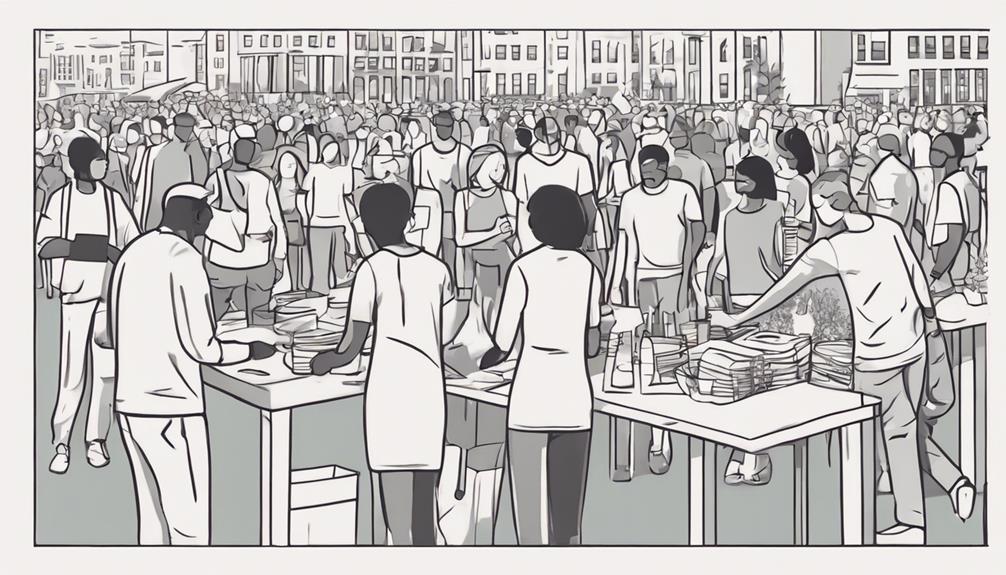
In facilitating effective disaster relief efforts, strategic planning and execution of fundraising events play a critical role in mobilizing resources and community support for those affected by emergencies. Creative fundraising ideas are essential to attract donors, such as organizing auctions, benefit concerts, or charity runs. Collaborating with local businesses and sponsors can enhance fundraising events and increase community involvement. Social media promotion strategies are vital for reaching a broader audience; utilizing platforms like GoFundMe can facilitate donation collection. Offering unique experiences or items for auction can help maximize fundraising potential. Volunteer recruitment tactics are crucial in ensuring the smooth operation of fundraising events. Transparency and accountability are key; clearly communicating how raised funds will be used for disaster relief efforts builds trust with donors. By implementing these strategies, fundraising events can be successful in generating support for those impacted by disasters.
Send Supplies to Affected Areas
When sending supplies to disaster-affected areas, it is crucial to coordinate donation efforts to ensure that the items being sent align with the immediate supply needs identified by relief organizations. By contacting accredited organizations, donors can verify the specific items required in evacuation and recovery zones, such as medical supplies and food for initial relief. This coordination helps avoid sending unnecessary goods that could impede relief operations and overwhelm resources, allowing for a more effective allocation of donations.
Immediate Supply Needs
To effectively assist those impacted by disasters, it is crucial to coordinate with accredited organizations to determine the specific immediate supply needs of affected areas before sending any supplies. When considering relief distribution, emergency response, and supply coordination, the following items are commonly required in evacuation zones:
- Medical Supplies: Crucial for providing immediate relief to those injured or in need of medical attention.
- Food: Essential for sustaining individuals in the affected areas until further assistance arrives.
- Heavy Equipment: Needed for clearing debris and restoring infrastructure to enable relief efforts.
- Generators: Vital for providing power in areas where the electrical grid has been compromised.
Sending these necessary items promptly can significantly impact the success of emergency response efforts.
Coordinate Donation Efforts
Effective coordination of donation efforts plays a crucial role in ensuring that essential supplies reach affected areas swiftly and efficiently. Supply coordination involves contacting accredited organizations to confirm the necessity and effective distribution of items before sending them. This step prevents overwhelming relief distribution systems with unnecessary goods, which could impede the delivery of crucial materials like medical supplies, food, and hygiene products to evacuation zones. Resource allocation should prioritize high-demand items such as heavy equipment, construction materials, and generators for supporting recovery and rebuilding efforts. Emergency shipping services play a vital role in expediting the transportation of life-saving materials to affected regions, ensuring a timely response to disaster-stricken areas.
Offer Assistance in Recovery Zones
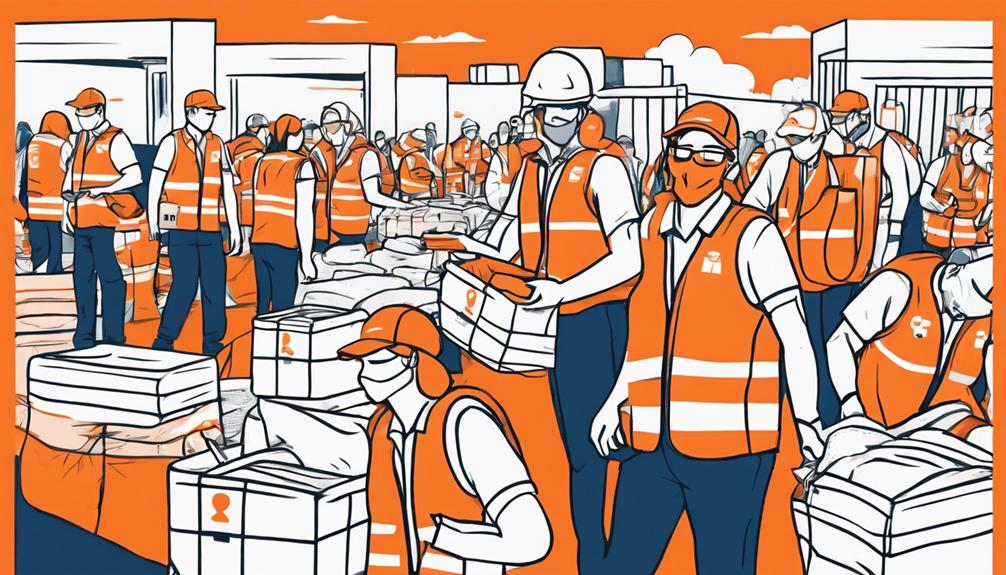
Following the aftermath of disasters, it is imperative to provide targeted assistance in the designated recovery zones to aid in the reconstruction and rehabilitation efforts. This assistance can take various forms, including:
- Volunteer Opportunities: Mobilizing volunteers to assist in cleanup, distribution of supplies, and providing support to affected individuals and families.
- Financial Aid: Offering emergency financial assistance to help individuals and families in recovery zones meet immediate needs and begin the process of rebuilding.
- Recovery Support Programs: Implementing programs that provide emotional, psychological, and practical support to those navigating the challenges of post-disaster recovery.
- Grants for Rebuilding: Providing grants to support rebuilding efforts, address long-term household needs, and facilitate the restoration of communities affected by disasters.
Contribute to Safe Water Initiatives
In disaster-affected regions, supporting safe water initiatives is paramount for preventing waterborne diseases and promoting essential hygiene practices. Access to clean water remains a critical need, especially in areas struck by disasters where water sources may be contaminated. Organizations such as Oxfam and UNICEF play a crucial role in providing safe water solutions, sanitation facilities, and hygiene education to communities facing emergencies. To address the water crisis effectively, various water purification methods, community engagement strategies, and sustainable solutions are essential.
| Water Purification Methods | Community Engagement | Sustainable Solutions |
|---|---|---|
| Water purification tablets | Involving locals in decision-making processes | Implementing long-term water management plans |
| Filtration systems | Conducting hygiene awareness campaigns | Promoting water conservation practices |
| Water storage containers | Establishing community water committees | Investing in infrastructure for safe water access |
Help Save Animal Lives in Disasters
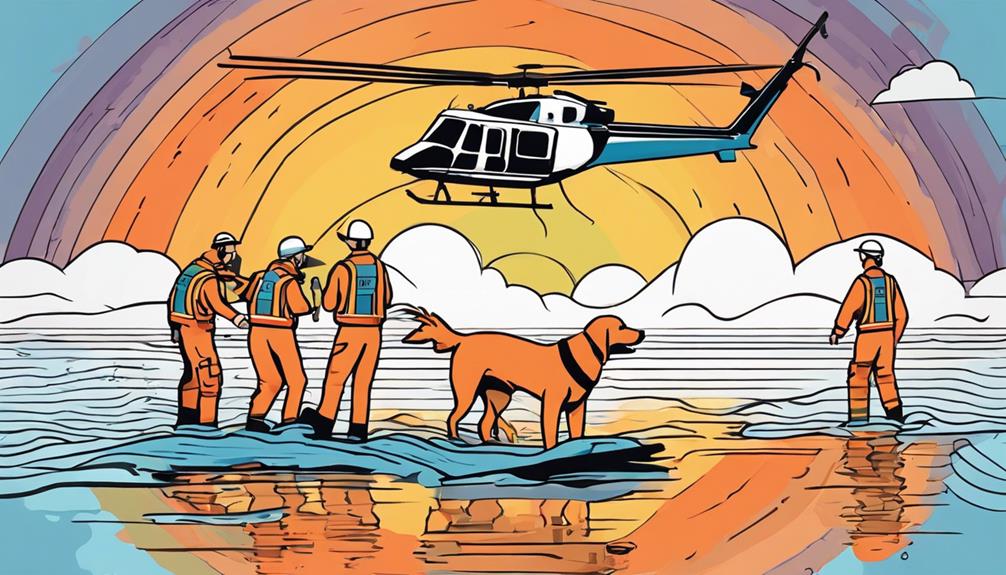
Addressing the welfare of animals affected by disasters is an integral component of comprehensive disaster relief efforts. In times of crisis, animals often face peril and abandonment, emphasizing the critical importance of animal rescue missions, emergency pet care, and wildlife protection efforts. To effectively save animal lives in disasters, the following steps are essential:
- Animal Rescue Missions: Organizations like the Humane Society work tirelessly to rescue animals in distress during disasters such as hurricanes, earthquakes, and wildfires.
- Emergency Pet Care: Providing immediate medical care, shelter, and food to pets affected by disasters is crucial for their survival and well-being.
- Wildlife Protection Efforts: Safeguarding natural habitats, endangered species, and wildlife populations from the impact of disasters is vital for ecological balance and biodiversity conservation.
- Supporting Animal Welfare Organizations: Donations to shelters and rescue groups help in rescuing, sheltering, and reuniting pets with their owners, ensuring they receive the care and protection they need during and after disasters.
Explore Global Giving Opportunities
Global Giving offers a platform to fund relief efforts and provide crucial support to local communities affected by disasters worldwide. By contributing to Global Giving, individuals can help ensure access to safe water, sanitation, and hygiene in regions like Haiti and the Dominican Republic. Donations play a vital role in preventing diseases such as cholera and ultimately saving lives in disaster-impacted areas.
Funding Relief Efforts
Considering the urgent need for funding in disaster relief efforts worldwide, exploring global giving opportunities is crucial for making a meaningful impact. Here are four ways you can contribute to relief efforts:
- Support earthquake relief in Mexico City and surrounding areas through Global Giving.
- Provide safe water and sanitation to prevent diseases in Haiti and the Dominican Republic with Oxfam.
- Assist the Barbuda Red Cross in providing essential supplies and volunteer aid.
- Help save animal lives in Mexico and Puerto Rico by donating to the Humane Society.
These avenues offer opportunities to provide emergency funding, community support, and financial assistance to aid in recovery efforts globally. Your contributions can make a direct impact on those affected by disasters.
Supporting Local Communities
In light of the critical importance of supporting local communities affected by disasters, exploring opportunities for global giving through organizations like Global Giving is paramount for effective relief efforts. Global Giving facilitates disaster recovery by partnering with local organizations, ensuring that donations provide essential resources such as food, shelter, and medical aid where they are most needed. Through these local partnerships, community empowerment becomes a central focus, allowing affected populations to actively participate in and drive their own recovery process. By supporting Global Giving initiatives, donors can witness firsthand how their contributions make a tangible difference in the lives of those impacted by disasters. This approach not only aids in immediate relief but also lays a foundation for long-term resilience and sustainable recovery within these communities.
Engage in Company Donation Matching
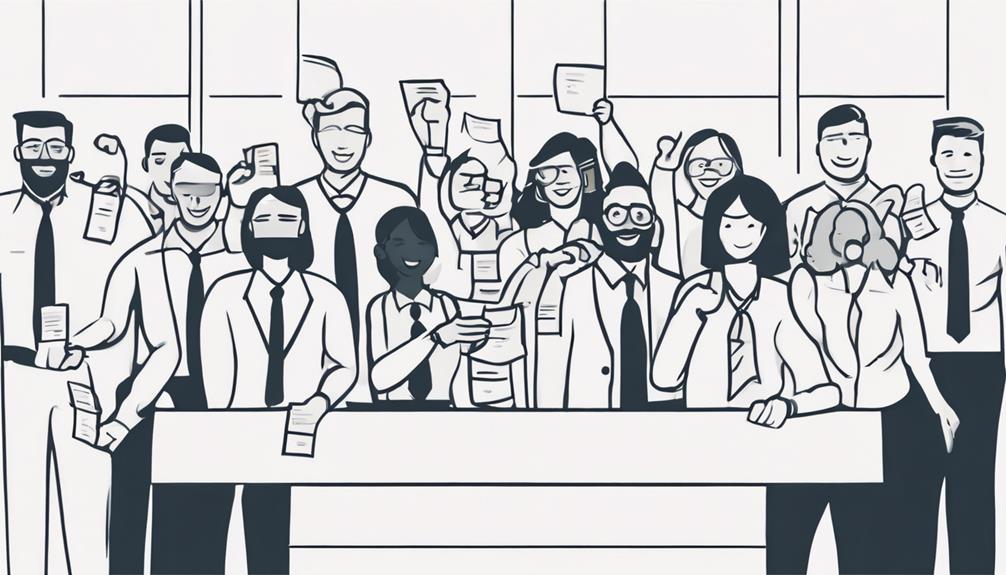
Utilizing company donation matching initiatives can significantly enhance the impact of individual contributions towards disaster relief efforts. Corporate partnerships with companies such as Pacsun, Facebook, Google, and Amazon are actively matching donations to aid in disaster relief. Here are four reasons why engaging in company donation matching is crucial in amplifying impact:
- Increased Financial Support: Matching donations from companies help amplify the impact of individual contributions, providing a more substantial financial base for disaster relief efforts.
- Employee and Customer Engagement: Corporate donation matching programs encourage employees and customers to support disaster relief, fostering a sense of community and shared responsibility.
- Multiplication of Funds: Matching funds from companies can double or even triple the amount donated, effectively multiplying the resources available to help those affected by disasters.
- Boost to Relief Initiatives: Engaging in company donation matching programs can significantly boost financial support for disaster relief initiatives, enabling a more robust and effective response to emergencies.
Frequently Asked Questions
How Can We Help People Who Are Affected by the Disasters?
In times of disasters, community support plays a vital role in aiding those affected. Emergency response efforts should prioritize mental health support alongside material donations. Providing shelter and essential resources is crucial for the affected population's recovery. Donations to reputable organizations can ensure efficient allocation of funds. Supporting disaster relief initiatives through various means can significantly impact the well-being of individuals grappling with the aftermath of catastrophic events.
How Can We Overcome the Effects of Natural Disasters?
To overcome the effects of natural disasters, a comprehensive approach is needed, focusing on rebuilding communities, providing effective disaster relief, and offering essential mental health support. This involves investing in resilient infrastructure, implementing early warning systems, and enhancing disaster preparedness measures. Collaboration among governments, organizations, and communities is crucial for a coordinated response. Additionally, research and innovation play a key role in developing strategies to mitigate disaster risks and create more resilient societies.
How Can People Cope up With Disaster?
Coping with disasters involves prioritizing mental health through strategies like seeking professional support, utilizing community resources, and enhancing emergency preparedness. Mental health resilience post-disaster can be bolstered through engaging in stress-relief activities, maintaining routines, and staying connected with loved ones. Education about disaster recovery resources and protocols is crucial for effective coping strategies. By fostering mental well-being, leveraging community support, and enhancing emergency preparedness, individuals can navigate the challenges of disaster aftermath more effectively.
How Can We Protect Ourselves From Disasters?
To protect ourselves from disasters, we must implement preventive measures such as reinforcing our homes, creating emergency kits with essentials like water and non-perishable food, and developing evacuation plans with designated safe areas. For example, securing doors and windows can mitigate damage during hurricanes or floods. By being proactive and prepared, we can increase our chances of safety and reduce the impact of disasters on our lives.
Conclusion
In conclusion, by supporting reputable relief organizations, providing essential items, donating blood, volunteering with vetted agencies, and contributing to emergency response efforts, we can make a significant impact in aiding disaster-affected individuals and communities. Through these collective actions, we can be the guiding light in the darkness of despair, offering hope and assistance to those in need. Let us stand together as a beacon of support, illuminating the path towards recovery and resilience.
